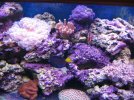Actually from reading, bacteria of different types they thrive on different size particles
Scoot he is just wrong on that. bacteria will populate on anything as long as the enviroment is correct, ie, correct water parameters and food source. Here is how they line up.
>aerobes predominate initially, because oxygen inhibits nitrate and sulfate reduction
>facultative anaerobes begin to predominate as oxygen concentration decreases
>anaerobes predominate when oxygen is exhausted and fermentation products (hydrogen, organic acids) accumulate
iron or manganese) reducers (Shewanella) predominate at first
>nitrate reducers (Pseudomonas, etc.) predominate next
>sulfate reducers (Desulfovibrio, etc.) predominate next, because they compete better for hydrogen than methanogens (but only if the sulfate concentration is high)
>carbon dioxide reducers (methanogens) predominate after the sulfate supply is exhausted
I am trying to stay away from the fine particles. The reason fine particles are used is to maximise surface population. I am willing to sacrifice an ammount in order to not have to worry about clogging. Also remember bacteria will not only populate the sand particle but also the organics and waste particles that inhabit the spaces inbetween the sand particles. I dont want to base any system on someone that can keep one up and running himself, so i am not to worried about Ron. The biology is the biology. Scoot you are dead on about populating the bacteria and instaling critters.
Nikki good thought. I dont know if that is a good thing or a bad. Lets follow the path of the food. Food is dumped in the main tank, most of the larger particles are uptaken by fish or gravity forces them down to the bootom of the tank where other scavengers wil get them. The balance of any uneaten food will go down the overflow and say directly or indirectly into plenum tank. Larger particles would stick in the gravel, but I believe those would be the ones that the larger critters (ie worms, snails, pods cukes conches and so on) would go after right away. What ever happened to make its way past all that and end up in the plenum, would sit thier, probibly would be attacked by Methagene bacteria. But if you had good enough holes in the pipes I think it could be succked out no problemo

